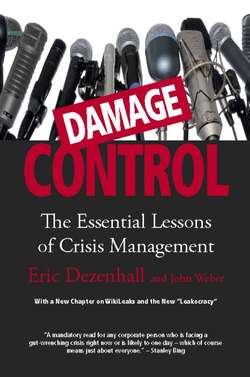Читать книгу Damage Control (Revised & Updated) - Eric Dezenhall - Страница 17
На сайте Литреса книга снята с продажи.
ОглавлениеCHAPTER 2
Know the Difference Between a Nuisance, a Problem, a Crisis, and a Marketplace Assault
[Sudden acceleration] is a mysterious phenomenon in which a short, silly, middle-aged woman with a lawyer gets into an Audi 5000 and—all of a sudden, for no apparent reason—goes through the back wall of her garage and onto the CBS 60 Minutes television program.
—P. J. O’ROURKE
In order to cure an ailment, you must first know what the ailment is. In crisis management, one of the greatest challenges lies in diagnosis. Perhaps the most common misdiagnosis in high-stakes public relations is confusing a communications problem with a conflict.
In a communications problem, some information is lacking. Education and awareness-building can cure the problem. If, for example, people are aware they are at risk for heart disease, they will be able to take tangible steps to prevent it—exercise, eat right, have regular checkups. There’s no side in the conversation making an argument against better health.
But in a conflict, there are sides, with opposing agendas. Information isn’t missing from the conversation; in fact, there’s no introducible bit of information that could change the mind of one side or the other.
In these zero-sum, my-side-versus-your-side conflicts, it is a big mistake to envision the battleground as a graph in which data points are charted and the side with more impressive data wins. A real PR war is multidimensional, with conflicting facts colliding with opposing agendas and unpredictable vicissitudes.
While we call our business “crisis management,” more often than not we are really navigating such marketplace assaults, which are different from pure crises. A crisis is a house that caught on fire because lightning struck. The event was organic, an act of nature. In a marketplace assault, someone wanted the house to be on fire, so they torched it (and placed incendiary devices around the house to sabotage the work of firefighters).
When a business is under a marketplace assault, often, the other side’s agenda has a legitimate component. In a marketplace assault, a crisis, such as a corporate bankruptcy due to scandal, meets an agenda, such as a plaintiff’s attorney looking to profit from the crisis in addition to recovering his client’s assets. In another example, the pharmaceutical industry must respond not only to legitimate concerns about drug safety but also to the public’s outrage over corporate profits and the cost of drugs.
A case in point: A few years ago, an ostensibly “concerned citizen” began alleging online that mainstream feminine care products were harming women with residue supposedly left over from the manufacturing process. It was an allegation that had to be taken seriously because in 1980, women died from toxic shock syndrome, a disease associated with a tampon product that is no longer on the market. Some within the brand manufacturing companies wanted to address these new allegations as a crisis, believing that a public education campaign explaining the falsity of this person’s claims would prove the allegations were unfounded.
The problem with this approach was that the “activist” spreading the rumors was not an ordinary citizen. She was, in fact, affiliated with the manufacturer of an “organic” tampon product competing for market share, and she was launching a marketplace assault. This motivated adversary was financially vested in the argument that branded products (e.g., Tampax, Kotex, Playtex) were hazardous, and no amount of “public education” was going to change that.
Once we realized what our client was up against, we suggested abandoning the crisis management strategy of productattribute public education. Some within our client’s company bristled, having already convinced themselves that such a campaign would improve their company’s PR. As crisis managers, however, we are loyal to our client’s well-being, not to a strategy. We believe in being flexible and are willing to abandon strategies when the operating climate changes. Eventually, with some convincing, we shifted our focus to exposing the smear apparatus that had been cynically created to scare women into buying the organic product. The consumer media, to its credit, became outraged to learn they had been misled by the organic company’s guerrilla campaign. The bad news about brand-name tampons eventually went away and sales of brand feminine-care products recovered. Much of the effort’s ultimate success was due to our client’s trust and willingness to cast aside a strategy that was management’s favorite earlier in the process.
For the most part, a marketplace assault must be navigated, not “managed”—an arrogant notion that falsely assumes that you, as the principal, are in total control of your destiny. You’re not; you’re only in control of your role in a series of collisions between dynamic variables—quantifiable hazards, agendas, personalities, politics, the mood of the culture.
